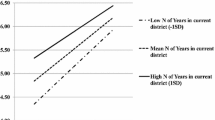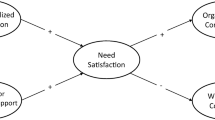Abstract
Given the changing landscape of postsecondary faculty employment, institutions benefit from understanding how organizational policies and behaviors affects the faculty’s perception of organizational support. Using data from faculty members, including those with contingent and part-time appointments, at a single institution in the western United States, this study examined how the faculty’s perceptions of structures and behaviors at the departmental, college, and campus levels affect their perception of organizational support. Results suggest that part-time faculty members are significantly less likely to feel supported; however, as their perceptions of being valued by college and senior administrators increase, so do their perceptions of support. Findings suggest avenues for organizational leaders to promote commitment among all faculty members.
Similar content being viewed by others
References
Allen, M. W. (1992). Communication and organizational commitment: Perceived organizational support as a mediating factor. Communication Quarterly, 40, 357–367.
Allison, P. D. (2012). Logistic regression using the SAS system: Theory and application. Cary, NC: SAS Press.
Altbach, P. G. (2000). The deterioration of the academic estate: International patterns of academic work. In P. G. Altbach (Ed.), The changing academic workplace: Comparative perspectives (pp. 1–23). Boston, MA: Center for International Higher Education.
American Association of University Professors. (2017). Trends in the academic labor force, 1975–2015. Retrieved from https://www.aaup.org/sites/default/files/Academic_Labor_Force_Trends_1975-2015.pdf
Azziz, R. (2014). A looming challenge in higher education: Our changing student. The Huffington Post. Retrieved from http://www.huffingtonpost.com/dr-ricardo-azziz/a-looming-challenge-higher-education_b_4855108.html
Ball, J. A. (2013). Organizational citizenship behavior at Catholic institutions of higher education: Effects of organizational commitment, interpersonal-and system-level trust. (Doctoral dissertation, University of Iowa, Iowa City, Iowa, U.S.A.). Retrieved from https://ir.uiowa.edu/etd/4945/
Barnhardt, C. L., & Phillips, C. W. (2018). At the margins of university work: The influence of campus climate and part-time faculty status on academic values. Journal of Academic Freedom, 9, 1–21.
Bergquist, W. H. (1992). The four cultures of the academy. San Francisco, CA: Jossey Bass.
Bland, C. J., Center, B. A., Finstad, D. A., Risbey, K. R., & Staples, J. (2006). The impact of appointment type on the productivity and commitment of full-time faculty in research and doctoral institutions. The Journal of Higher Education, 77, 89–122.
Borchers, A., & Teahen, J. (2001). Organizational commitment of part-time and distance faculty. AMCIS 2001 Proceedings, 41. Retrieved from http://aisel.aisnet.org/amcis2001/41
Brown, C. M., & Dancy, E. T. (2010). Predominantly white institutions. In K. Lomotey (Ed.), Encyclopedia of African American education (pp. 524–527). Thousand Oaks, CA: SAGE. doi https://doi.org/10.4135/9781412971966.n193
Carver, L. L. (2008). Organizational commitment and generational differences in nursing faculty (Doctoral dissertation, University of Nevada, Las Vegas, Nevada, U.S.A.). Retrieved from https://digitalscholarship.unlv.edu/rtds/2784
Collins, L. M., Schafer, J. L., & Kam, C. M. (2001). A comparison of inclusive and restrictive strategies in modern missing data procedures. Psychological Methods, 6, 330–351.
Daly, C. J., & Dee, J. R. (2006). Greener pastures: Faculty turnover intent in urban public universities. Journal of Higher Education, 77, 776–803.
Desrochers, D. M., & Kirshstein, R. (2014). Labor intensive or labor expensive? Changing staffing and compensation patterns in higher education. Issue brief. Delta Cost Project at American Institutes for Research. Retrieved from https://deltacostproject.org/sites/default/files/products/DeltaCostAIR_Staffing_Brief_2_3_14.pdf
Dillman, D. A. (2000). Mail and internet surveys: The tailored design method (2nd ed.). New York, NY: Wiley.
Dolan, V. L. (2011). The isolation of online adjunct faculty and its impact on their performance. The International Review of Research in Open and Distributed Learning, 12(2), 62–77.
Eisenberger, R., & Stinglhamber, F. (2011). Perceived organizational support: Fostering enthusiastic and productive employees. Washington, DC: APA Books.
Eisenberger, R., Huntington, R., Hutchison, S., & Sowa, D. (1986). Perceived organizational support. Journal of Applied Psychology, 71, 500–507.
Eisenberger, R., Cotterell, N., & Marvel, J. (1987). Reciprocation ideology. Journal of Personality and Social Psychology, 53, 743–750.
Engle, D. L. (2010). Factors that predict organizational commitment for full-time and part-time faculty in community colleges across North Carolina. (Doctoral dissertation). Retrieved from Dissertations and Theses. (UMI No. AAT 3425899).
Fjortoft, N. (1993, May). Factors predicting commitment to the university. Paper presented at the annual forum of the Association for Institutional Research, Chicago, Illinois.
Gappa, J. M., Austin, A. E., & Trice, A. G. (2007). Rethinking faculty work: Higher education's strategic imperative. San Francisco, CA: Jossey-Bass.
Hutchinson, S. (1997). A path model of perceived organizational support. Journal of Social Behavior and Personality, 12, 159–174.
Jing, L., & Zhang, D. (2014). Does organizational commitment help to promote university faculty’s performance and effectiveness? The Asia-Pacific Education Researcher, 23, 201–212.
Kezar, A. (2013). Examining non-tenure track faculty perceptions of how departmental policies and practices shape their performance and ability to create student learning at four-year institutions. Research in Higher Education, 54, 571–598.
Kezar, A., & Sam, C. (2011). Understanding non-tenure track faculty: New assumptions and theories for conceptualizing behavior. American Behavioral Scientist, 55, 1419–1442.
Kezar, A., & Sam, C. (2014). Governance as a catalyst for policy change: Creating a contingent faculty friendly academy. Educational Policy, 28, 425–462.
Kezar, A., DePaola, T., & Scott, D. (2019). The gig academy: Mapping labor in the neoliberal university. Baltimore, MD: Johns Hopkins University Press.
Knapp, L. G., Kelly-Reid, J. E., & Ginder, S. A. (2010). Employees in postsecondary institutions, fall 2009, and salaries of full-time instructional faculty, 2009–10 (NCES 2011–150). Washington, DC: National Center for Education Statistics. Retrieved from https://nces.ed.gov/pubs2011/2011150.pdf
Lawrence, J., Ott, M., & Bell, A. (2012). Faculty organizational commitment and citizenship. Research in Higher Education, 53, 325–352.
Leslie, D. W., & Gappa, J. M. (2002). Part-time faculty: Competent and committed. New Directions for Community Colleges, 118, 59–67.
Levin, J. S., & Shaker, G. G. (2011). The hybrid and dualistic identity of full-time non-tenure-track faculty. American Behavioral Scientist, 55, 1461–1484.
Maynard, D. C., & Joseph, T. A. (2008). Are all part-time faculty underemployed? The influence of faculty status preference on satisfaction and commitment. Higher Education, 55, 139–154.
Meyer, J. P., & Allen, J. N. (1997). Commitment in the workplace: Theory, research, and application. Thousand Oaks, CA: SAGE.
Mowday, R. T., Porter, L. W., & Steers, R. M. (1982). Employee-organizational linkages: The psychology of commitment, absenteeism, and turnover. New York, NY: Academic Press.
National Center for Education Statistics. (2010). Projections of education statistics to 2021 (40th ed.). Washington, DC: National Center for Educational Statistics Retrieved from http://nces.ed.gov/pubs2013/2013008.pdf
Neumann, Y., & Finaly-Neumann, E. (1990). The reward-support framework and faculty commitment to their university. Research in Higher Education, 31, 75–97.
Ott, M., & Cisneros, J. (2015). Understanding the changing faculty workforce in higher education: A comparison of non-tenure track and tenure line experiences. Education Policy Analysis Archives, 23(90). Retrieved from https://epaa.asu.edu/ojs/article/view/1934
Pascarella, E. T., & Terenzini, P. T. (2005). How college affects students: A third decade of research. San Francisco, CA: Jossey-Bass.
Rhoades, G. (1998). Managed professionals: Unionized faculty and restructuring academic labor. Albany, NY: State University of New York Press.
Rhoades, L., & Eisenberger, R. (2002). Perceived organizatonal support: A review of the literature. Journal of Applied Psychology, 87, 698–714.
Santos Laanan, F. (Ed.). (2006). Editors notes. Students in transitions: Trends and issues. New Directions for Student Services, 114, 1–6.
Schuster, J. H., & Finkelstein, M. J. (2006). The American faculty: The restructuring of academic work and careers. Baltimore, MD: Johns Hopkins University Press.
Sheets, J. K. E., Barnhardt, C. L., Phillips, C. W., & Valdes, P. H. (2018). The impact of faculty work-life factors on faculty service morale. Journal of Faculty Development, 32(2), 1–13.
Sluss, D. M., & Ashforth, B. E. (2008). How relational and organizational identification converge: Processes and conditions. Organization Science, 19, 807–823.
Thelin, J. R. (2001). Campus and community: A world turned inside out? The Review of Higher Education, 25, 1–14.
Umbach, P. D. (2007). Faculty cultures and college teaching. In R. P. Perry & J. C. Smart (Eds.), The scholarship of teaching and learning in higher education: An evidence-based perspective (pp. 263–317). New York, NY: Springer.
Zhou, Y., & Volkwein, J. F. (2004). Examining the influences on faculty departure intentions: A comparison of tenured versus nontenured faculty at research universities using NSOPF-99. Research in Higher Education, 45, 139–176.
Author information
Authors and Affiliations
Corresponding author
Additional information
Publisher’s Note
Springer Nature remains neutral with regard to jurisdictional claims in published maps and institutional affiliations.
Appendix
Appendix
Rights and permissions
About this article
Cite this article
Culver, K.C., Young, R.L. & Barnhardt, C.L. Communicating Support: Examining Perceived Organizational Support among Faculty Members with Differing Appointment Types. Innov High Educ 45, 299–315 (2020). https://doi.org/10.1007/s10755-020-09503-z
Published:
Issue Date:
DOI: https://doi.org/10.1007/s10755-020-09503-z




